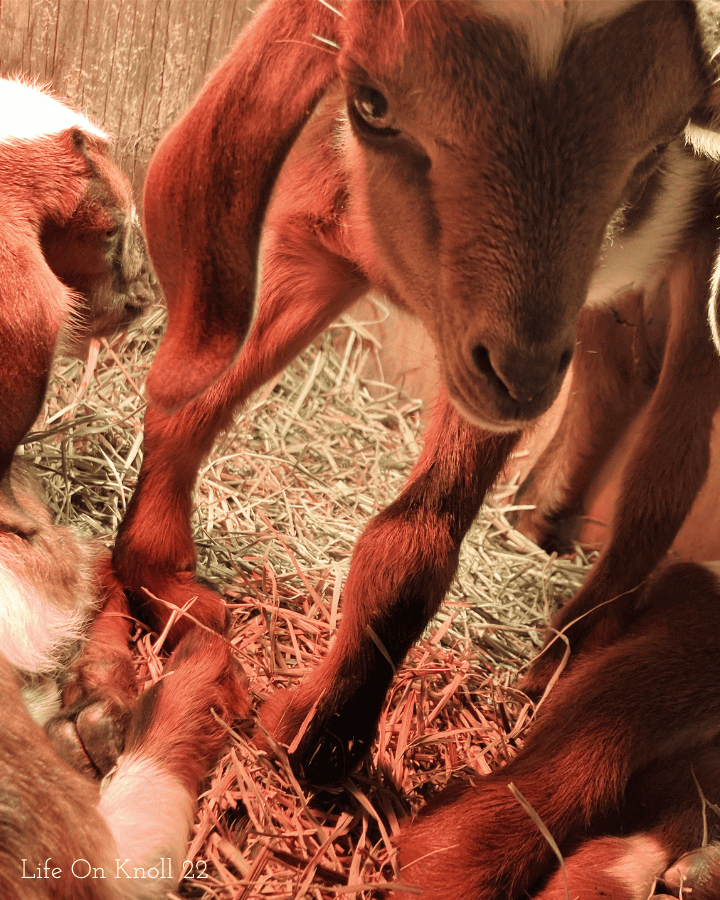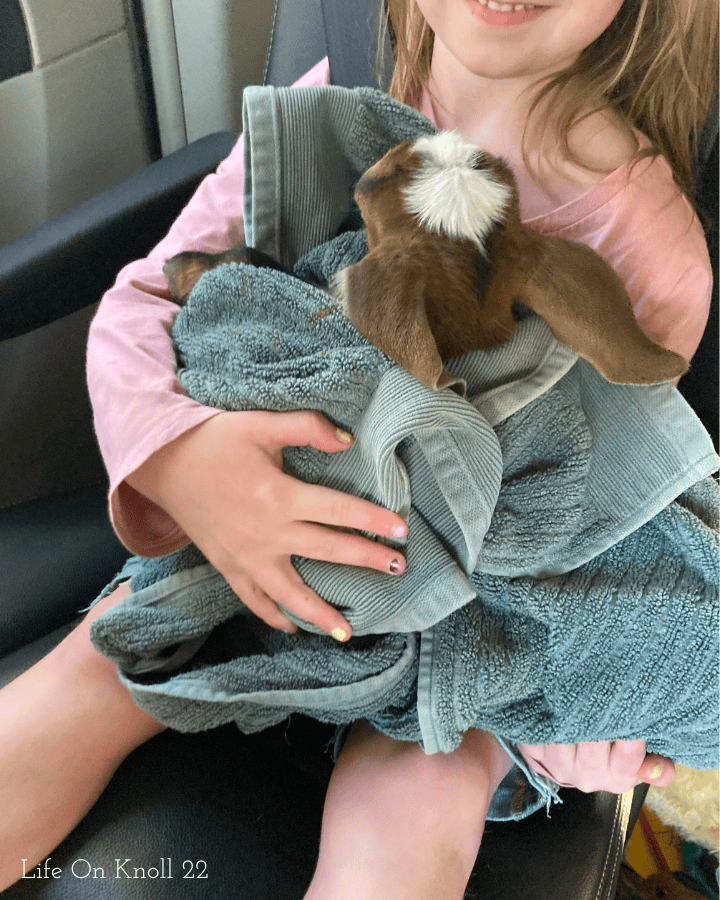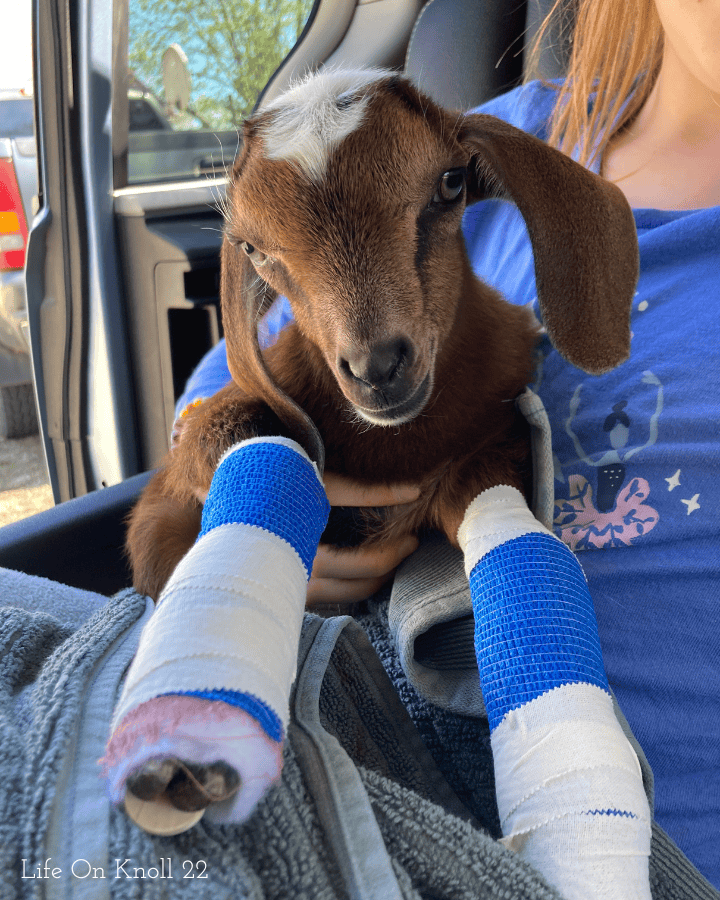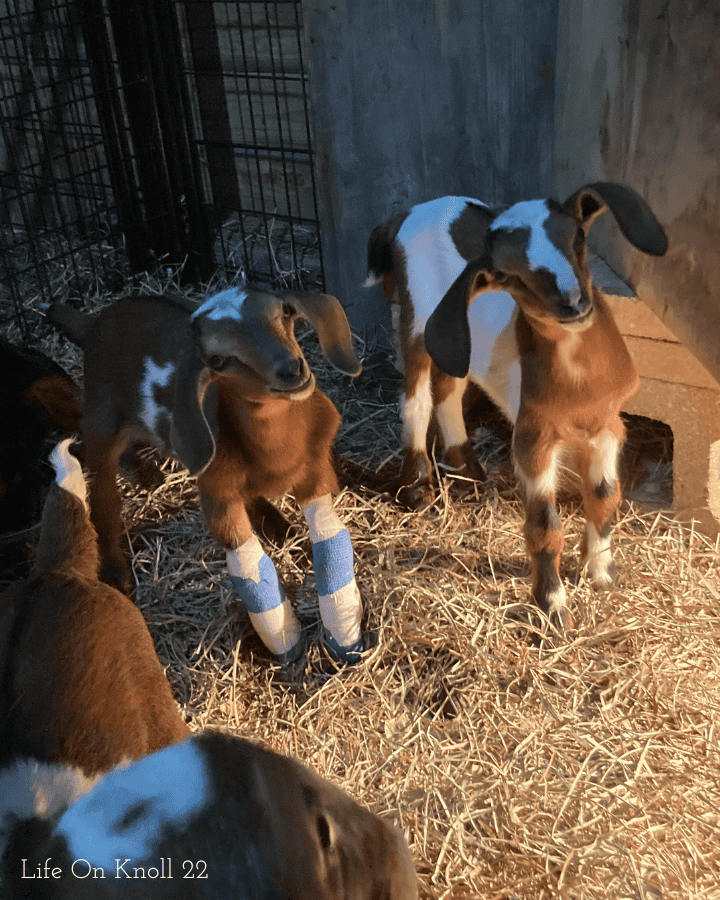A mini-Nubian goat kid born with bent legs, very weak, and a limited interest in suckling, led us to discover the effects of Vitamin E and selenium deficiency in goats.

Triplets
My husband called to me in the early hours of the morning one April night. “Can you come help?” Our nanny, Alice, gave birth to her first batch of kids, triplets, and the littlest one was struggling.
While we were as prepared as we could have been based on our other kidding experiences, we have learned that new challenges seem to present themselves. In the weeks before we moved the momma-to-be into a kidding stall in the shed, and had set up a warming area for the kids, which included a heat lamp. We had probiotics, colostrum replacer, and bottles and other supplies on hand.
Although we were not there for the delivery, as I arrived in the shed that night, my husband had already set up a space heater and grabbed a couple towels to help dry the kids off. Of course, she had to choose the coldest night of the week, when temperatures were dropping below freezing and frost covered the ground outside.
Being a first time mom, she didn’t seem to have done very good at getting the kids licked off and dry, so I went about towel drying the littlest kid, while sitting in front of the space heater where we could both stay warm. The first two kids were much bigger and already up and walking around, but this one was quite a bit smaller and was struggling to even stand.
Something Was Wrong
After several attempts to get it to nurse, I decided it was time to prepare a bottle of IgG colostrum replacer. It didn’t latch well, but was able to swallow the nourishment as it dripped into its mouth. So began the process of a 3-4 hour feeding schedule in an attempt to keep the little one alive and strengthened.
Be the second feeding it was obvious this kid has something wrong with its legs. It was still weak and couldn’t stand, but also had a strange bow leggedness. It was now able to nurse from mom, with a little help finding its way, as we held it under her body. At a day old it was able to stand, and could move slightly here or there, but did so in a funny hopping, motion. The joints on its front legs were unable to fully extend straight, and it walked with a “tiptoed” motion, or even on its front ankles or knees, as every things bent backwards under its body.
Someone on my social media account messaged me suggesting we splint the let to encourage it to grow straight. This thought hadn’t even come to mind, but it was a good one, so i began doing a little research on splinting goats. After a quick online search selenium deficiency quickly came to the forefront. I found several online forums and boards sharing similar cases of bend legs, and some recommendations for treatment options.
Selenium deficiency certainly seemed to be a factor, and we now had hope that this little kid had opportunity at a normal life, not one with a malformed disability.

Selenium-Tocopherol Deficiency – White Muscle Disease
White Muscle Disease (WMD) is a disease syndrome that presents itself in calves, lambs, and goats. WMD is a result of selenium and tocopherol (Vitamin E) deficiency. As the name suggests it affects the muscles, often resulting in weakness or hardening. Presence of the disease results in white spots forming on cardiac and skeletal muscles.
Signs of the Disease
- -muscle stiffness and lameness
- -inability to suckle
- -diarrhea
- -sudden death from cardiac arrest
- -lung related issues
- -low growth rate
- -progressive paralysis
Future Prevention
Going forward we can take attempts to supplement the nanny during her final weeks of pregnancy. We can also give newborn kids a supplementary treatment after birth. Hopefully, this will prevent any future occurrences of WMD in our herd.
Ensuring adequate access to selenium in forage and vitamin supplement is also an important part of future prevention. I’ll mention more on that toward the end of the post.
Addressing the Deficient Nutrients
Vitamin E
Vitamin E is actually not just one ingredient, but a group of 8 different fat soluble compounds. Four of these compounds are tocopherals and the other four are tocotrienols. Vitamin E deficiency can lead to issues with the nerves such as nerve pain. It also plays important roles in vision, reproduction, and brain function.
Selenium
Selenium is a mineral nutrient this is also a chemical element on the periodic table. Acting as an antioxidant, selenium can support metabolism, immune system function, and thyroid health, along with possible prevention of heart disease, decline in cognitive function, and heart related issues.
Selenium and Vitamin E work synergistically to prevent oxidation of the cell membranes. Selenium also aids in the metabolism of other nutrients like copper, mercury, sulfer, and Vitamin E.
Treatment Options for Selenium Deficiency in Goats
Obviously the best way to resolve a nutrient deficiency, and alleviate the resulting symptoms, is to give supplementary dosages of the missing nutrients. Two main treatment options seem to be available to address the selenium nutrient deficiency in goats. One is a product called Bo-Se and the other is an oral syringe. Both contain the same active ingredients (nutrients): Vitamin E and Selenium.
Bo-Se
Bo-Se is a medication to prevent and treat selenium deficiency in a variety of hoof stock, and is only available by prescription from a veterinarian.
By the time we learned all of this, it was already the weekend. Since we didn’t have an established relationship with a vet that we could contact after hours, we decided to look for the syringe option locally.
Ingredients: Selenium and Vitamin E (tocopherals)
Administration: Injection
Manufacturer: Merck (https://www.merck-animal-health-usa.com/species/cattle/products/bo-se)
Source: Veterinarian Prescription Only
Oral Syringe
If you’re looking for a treatment option that does not require a prescription you can purchase medication in oral gel syringe form. There are many different brands available from a variety of suppliers, both locally (farm stores) and online.
Ingredients: Varied
Administration: Oral
Manufacturer: Various (Durvet is a common brand)
Source: Farm Stores and Online Retailers
I made a trip to the Bomgaars in the town closest to us, no success. Talking to the employees there, I quickly learned they don’t carry much in the way of goat supplies and medication. My husband then made a trip to the closest “big” city and came up empty handed at Tractor Supply Co and Fleet Farm. With no other options, we made a Monday call to the vet for a farm visit. He was able to come out and administer the Bo-Se injection.
The Veterinary Visit
Four days after our kids were born, we were able to have a veterinarian visit our farm. He was able to give each of the goat kids a dosage of Bo-Se and examine the little one for issues concerning his legs. It was a the vet’s recommendation that we splint the legs to encourage them to grow straight and offer extra support when standing.

Splinting
The next morning I dropped the kid off at the vet’s office and he was able to splint both of the front legs. The recommended follow up timeline was two weeks.


Splint Removal and Recovery
After two weeks our vet removed the splints. Since he had not used his knee joints since a few days after birth it took some time before his walking patterns became more normal.

At one month of age, we gave the goat kids additional oral selenium to help compensate for the deficiency.
Feeding Proper Forage to Avoid Selenium Deficiency
I found the article linked below to be very helpful in identifying different types of forage and their selenium content. The document contains various tables outlining dosages, forage quality, soil deficiencies, etc.
https://sciencepublishinggroup.com/article/10.11648/j.ijaas.20160206.15
Where you live in can determine whether the forage in your area is deficient in any given nutrient. The article above is dated. However, after this whole turn of events with our goat kid, I was able to talk with my 92 year old grandfather, who said selenium deficiency in forage from the region he lived in was something he was aware of back when he was dairy farming decades ago (1960’s-1980’s). Similarly, some regions can produce forage that is too high in selenium and can lead to toxicity.
Other Sources
https://www.mayoclinic.org/drugs-supplements-vitamin-e/art-20364144
*Please note that we did not have an official diagnosis of selenium deficiency or white muscle disease from our veterinarian. However, the purpose of this post is to educate on the disease and the method we used to address the issues we saw in our goat kid. which may have resulted from other unknown factors.

Leave a Reply